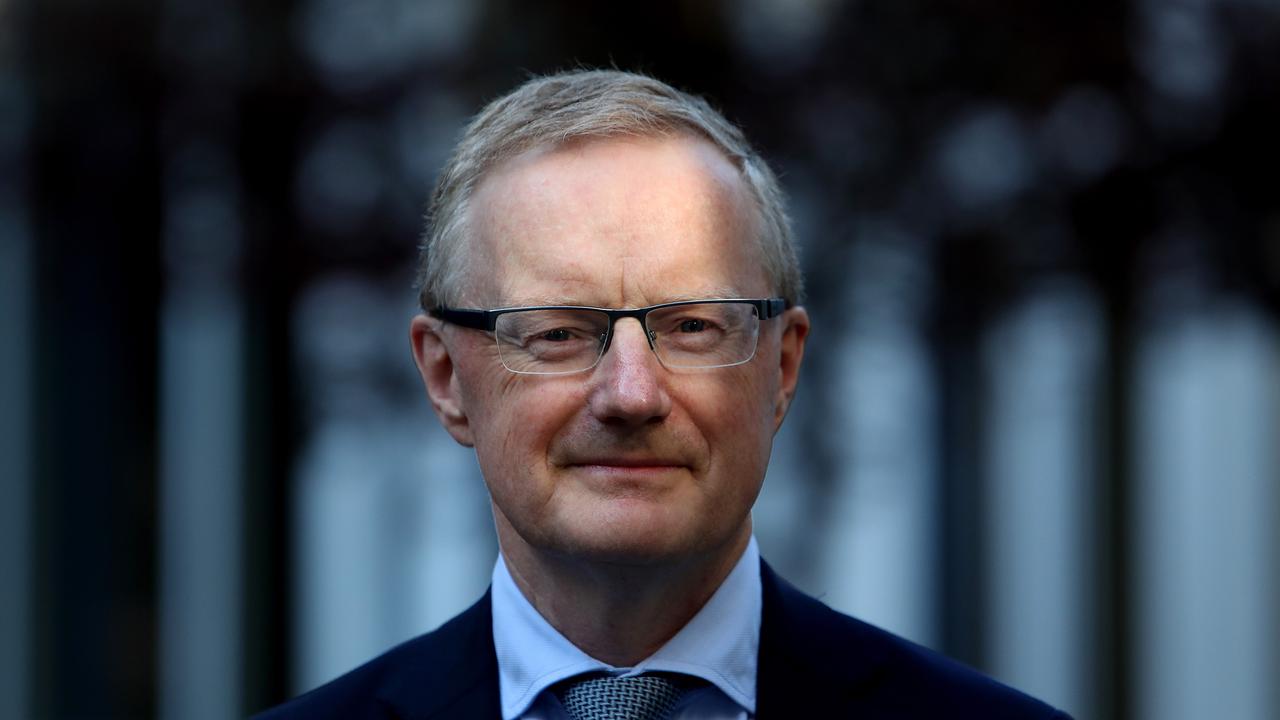RBA holds fire on ‘unconventional’ policy
The RBA says there is room for two more interest rate cuts to 0.25 per cent before drastic action is needed to save the economy.

Reserve Bank Governor Philip Lowe says negative interest rates are “extraordinarily unlikely” to be used in Australia, nor are any other unconventional policies.
Countries including Denmark, Sweden, Switzerland and Japan have taken interest rates below zero in the past to deal with financial crises and economic slowdowns.
Dr Lowe told a business economists dinner in Sydney on Tuesday so-called “unconventional” monetary policy options, beyond cutting interest rates, were again being discussed around the world.
However, they were not on the RBA’s agenda at this point in time.
“The Reserve Bank has long had flexible market operations that allow us to ensure adequate liquidity in Australian financial markets,” he said.
“We have used this flexibility in the past, particularly during the global financial crisis, and we are prepared to use it again in periods of stress if necessary. At the moment, though, Australia’s financial markets are operating normally and our financial institutions are able to access funding on reasonable terms.”
He said negative interest rates were “extraordinarily unlikely” as Australia was not in the same situation as parts of Europe and Japan.
“Our growth prospects are stronger, our banking system is in much better shape, our demographic profile is better and we have not had a period of deflation. So we are in a much stronger position.”

As well, the RBA had “no appetite” to go down the path of buying private sector assets as part of a quantitative easing program.
However, if the RBA were to take the decision “we would purchase government bonds, and we would do so in the secondary market”.
“An important advantage in buying government bonds over other assets is that the risk-free interest rate affects all asset prices and interest rates in the economy,” he said.
“So it gets into all the corners of the financial system, unlike interventions in just one specific private asset market.
He added, “Our current thinking is that QE (quantitative easing) becomes an option to be considered at a cash rate of 0.25 per cent, but not before that.”
At a cash rate of 0.25 per cent, Dr Lowe said the interest rate paid on surplus balances at the Reserve Bank would already be at zero “given the corridor system we operate”.
“So from that perspective, we would, at that point, be dealing with zero interest rates,” he said.
The threshold for undertaking QE in Australia had not been reached, he said.
“And I don’t expect it to be reached in the near future.”
Dr Lowe said the economy was benefiting from the already low level of interest rates, recent tax cuts, ongoing spending on infrastructure, the upswing in housing prices in some markets and a brighter outlook for the resources sector.
Economic growth was set to pick up, reaching three per cent in 2021, he said.
“We are expecting things to be moving in the right direction, although only gradually.”
However, he noted structural and fiscal policies “will sometimes be the better approach”.
“We need to remember that monetary policy cannot drive longer-term growth, but that there are other arms of public policy than can sustainably promote both investment and growth.”
The government has argued it is doing enough to stimulate the economy through bringing forward road and rail project spending and cutting income tax.
FOUR ‘UNCONVENTIONAL’ TOOLS
Negative interest rates
“This is one tool that is truly unconventional.
“Prior to the financial crisis, it was widely thought that zero was the lower bound for the policy interest rate – so it was common to talk about the ‘ZLB’, or the zero lower bound. It was thought that if interest rates went below zero, people would hold their savings in banknotes rather than be charged by their bank to deposit their money.
“But zero has not turned out to be the constraint that it was once thought to be. So we now talk about the ELB – the effective lower bound – not the ZLB. While countries with negative interest rates have seen some shift to banknotes, it has been on a limited scale only.
“This reflects the use of bank deposits for making transactions and the fact that most banks in countries with negative interest rates have set a floor of zero on retail deposit rates. These banks have judged that it doesn’t make sense, either commercially or politically, to charge households and small businesses negative interest rates on their deposits.
“It is worth pointing out that negative policy interest rates have largely been a European phenomenon. Policy interest rates have been negative in the euro area, Denmark, Sweden and Switzerland. Rates have been lowest in Switzerland, at minus 0.75 per cent. The only country outside of Europe that has had negative policy interest rates is Japan, but even there it is only a very small share of bank reserves at the Bank of Japan that earns a negative rate, at minus 0.1 per cent.”
Extended liquidity operations
“In response to the financial crisis, many central banks made significant changes to their normal market operations to deal with strains in financial markets that were impairing the supply of credit to the economy.
“While the specifics differ across countries, the changes to market operations included: expanding the range of collateral accepted; providing much larger amounts of liquidity; extending the maturity of liquidity operations; increasing the range of eligible counterparties; and providing funding to banks at below the cost that was then prevailing in highly stressed markets, sometimes on the condition that the banks provide credit to businesses and households.
“The biggest operations were during the crisis period of 2008 and 2009, with significant liquidity support also being provided in 2011 and 2012 to support bank lending during the European sovereign debt crisis.
“It is worth recalling that during these periods of stress, banks had become very nervous about their access to liquidity. This, in turn, made them nervous about lending to others, making the possibility of a severe credit crunch very real.
“By providing financial institutions with greater confidence about their own access to liquidity, central banks were able to support the supply of credit to the economy. There were some side-effects of doing this, but the strong conclusion of the report is that these measures eased liquidity strains in highly stressed bank funding markets and helped restore monetary transmission channels to the broader economy.”
Quantitative easing
“The outright purchase of assets from the private sector, paying for those assets by creating central bank reserves – also known as quantitative easing or QE.
“These asset purchases were on an unprecedented scale and led to very large expansions of central bank balance sheets. Before the financial crisis, the major central banks owned securities equivalent to around 5 per cent of GDP. In recent years, this has risen to nearly 30 per cent. This is a very large change.
“As part of their QE programs, central banks bought a wide range of assets, but the main asset purchased was government securities. Central banks now hold nearly 30 per cent of government securities on issue, which is equivalent to around 20 per cent of GDP. The largest purchases have been made by the Bank of Japan, which holds almost 50 per cent of Japanese government bonds on issue.
“In the US, the Federal Reserve also bought large quantities of agency securities backed by the US government. Elsewhere, central banks bought private securities such as covered bank bonds, corporate bonds and commercial paper. And the Bank of Japan bought equities via exchange traded funds (ETFs) and real estate investment trusts.
“The precise motivations for these asset purchase programs varied across countries, but a common motivation was to lower risk-free interest rates out along the term spectrum, well beyond the short-term policy rate.
“Buying government bonds was seen as reinforcing policy rate cuts and/or acting as a substitute for further reductions in the policy rate once it was at its lower bound. The expectation was that lower risk-free rates would flow through to most interest rates in the economy, boost asset prices and push down the exchange rate.”
Forward guidance
“This took two forms — calendar based and state based. Under calendar-based guidance, the central bank makes an explicit commitment not to increase interest rates until a certain point in time.
“Under state-based guidance, the central bank says it will not increase rates until specific economic conditions are met. We have seen examples of both in practice. Some central banks also have provided forward guidance regarding their asset purchase programs.
“A primary motivation of forward guidance is to reinforce the central bank’s commitment to low interest rates. A related motivation is to provide greater clarity about the central bank’s reaction function and strategy in unusual times.
“The experience has mainly been positive, with the guidance helping to reduce uncertainty. There are, however, some examples where a change in guidance caused market volatility. The ‘taper tantrum’ in the US in 2013 is an example of this.”
Source: RBA Governor Philip Lowe November 26, 2019 address to Australian Business Economists Dinner, ‘Unconventional Monetary Policy: Some Lessons From Overseas’



